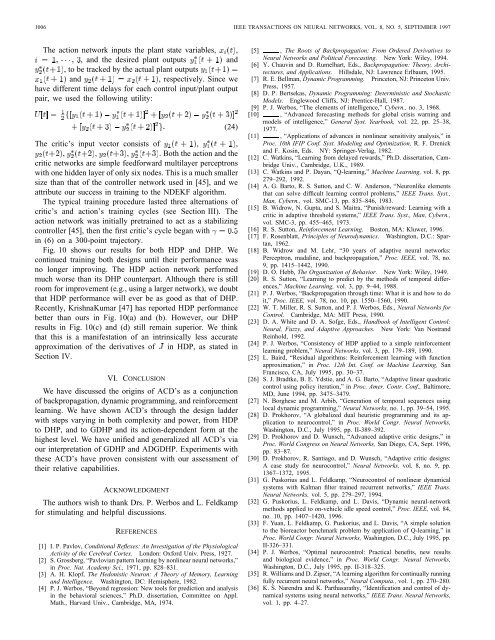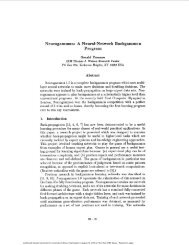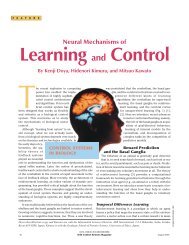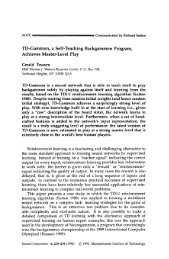Adaptive Critic Designs - Neural Networks, IEEE ... - IEEE Xplore
Adaptive Critic Designs - Neural Networks, IEEE ... - IEEE Xplore
Adaptive Critic Designs - Neural Networks, IEEE ... - IEEE Xplore
- No tags were found...
Create successful ePaper yourself
Turn your PDF publications into a flip-book with our unique Google optimized e-Paper software.
1006 <strong>IEEE</strong> TRANSACTIONS ON NEURAL NETWORKS, VOL. 8, NO. 5, SEPTEMBER 1997The action network inputs the plant state variables, ,, and the desired plant outputs and, to be tracked by the actual plant outputsand, respectively. Since wehave different time delays for each control input/plant outputpair, we used the following utility:(24)The critic’s input vector consists of , ,, , , . Both the action and thecritic networks are simple feedforward multilayer perceptronswith one hidden layer of only six nodes. This is a much smallersize than that of the controller network used in [45], and weattribute our success in training to the NDEKF algorithm.The typical training procedure lasted three alternations ofcritic’s and action’s training cycles (see Section III). Theaction network was initially pretrained to act as a stabilizingcontroller [45], then the first critic’s cycle began within (6) on a 300-point trajectory.Fig. 10 shows our results for both HDP and DHP. Wecontinued training both designs until their performance wasno longer improving. The HDP action network performedmuch worse than its DHP counterpart. Although there is stillroom for improvement (e.g., using a larger network), we doubtthat HDP performance will ever be as good as that of DHP.Recently, KrishnaKumar [47] has reported HDP performancebetter than ours in Fig. 10(a) and (b). However, our DHPresults in Fig. 10(c) and (d) still remain superior. We thinkthat this is a manifestation of an intrinsically less accurateapproximation of the derivatives of in HDP, as stated inSection IV.VI. CONCLUSIONWe have discussed the origins of ACD’s as a conjunctionof backpropagation, dynamic programming, and reinforcementlearning. We have shown ACD’s through the design ladderwith steps varying in both complexity and power, from HDPto DHP, and to GDHP and its action-dependent form at thehighest level. We have unified and generalized all ACD’s viaour interpretation of GDHP and ADGDHP. Experiments withthese ACD’s have proven consistent with our assessment oftheir relative capabilities.ACKNOWLEDGMENTThe authors wish to thank Drs. P. Werbos and L. Feldkampfor stimulating and helpful discussions.REFERENCES[1] I. P. Pavlov, Conditional Reflexes: An Investigation of the PhysiologicalActivity of the Cerebral Cortex. London: Oxford Univ. Press, 1927.[2] S. Grossberg, “Pavlovian pattern learning by nonlinear neural networks,”in Proc. Nat. Academy Sci., 1971, pp. 828–831.[3] A. H. Klopf, The Hedonistic Neuron: A Theory of Memory, Learningand Intelligence. Washington, DC: Hemisphere, 1982.[4] P. J. Werbos, “Beyond regression: New tools for prediction and analysisin the behavioral sciences,” Ph.D. dissertation, Committee on Appl.Math., Harvard Univ., Cambridge, MA, 1974.[5] , The Roots of Backpropagation: From Ordered Derivatives to<strong>Neural</strong> <strong>Networks</strong> and Political Forecasting. New York: Wiley, 1994.[6] Y. Chauvin and D. Rumelhart, Eds., Backpropagation: Theory, Architectures,and Applications. Hillsdale, NJ: Lawrence Erlbaum, 1995.[7] R. E. Bellman, Dynamic Programming. Princeton, NJ: Princeton Univ.Press, 1957.[8] D. P. Bertsekas, Dynamic Programming: Deterministic and StochasticModels. Englewood Cliffs, NJ: Prentice-Hall, 1987.[9] P. J. Werbos, “The elements of intelligence,” Cybern., no. 3, 1968.[10] , “Advanced forecasting methods for global crisis warning andmodels of intelligence,” General Syst. Yearbook, vol. 22, pp. 25–38,1977.[11] , “Applications of advances in nonlinear sensitivity analysis,” inProc. 10th IFIP Conf. Syst. Modeling and Optimization, R. F. Drenickand F. Kosin, Eds. NY: Springer-Verlag, 1982.[12] C. Watkins, “Learning from delayed rewards,” Ph.D. dissertation, CambridgeUniv., Cambridge, U.K., 1989.[13] C. Watkins and P. Dayan, “Q-learning,” Machine Learning, vol. 8, pp.279–292, 1992.[14] A. G. Barto, R. S. Sutton, and C. W. Anderson, “Neuronlike elementsthat can solve difficult learning control problems,” <strong>IEEE</strong> Trans. Syst.,Man, Cybern., vol. SMC-13, pp. 835–846, 1983.[15] B. Widrow, N. Gupta, and S. Maitra, “Punish/reward: Learning with acritic in adaptive threshold systems,” <strong>IEEE</strong> Trans. Syst., Man, Cybern.,vol. SMC-3, pp. 455–465, 1973.[16] R. S. Sutton, Reinforcement Learning. Boston, MA: Kluwer, 1996.[17] F. Rosenblatt, Principles of Neurodynamics. Washington, D.C.: Spartan,1962.[18] B. Widrow and M. Lehr, “30 years of adaptive neural networks:Perceptron, madaline, and backpropagation,” Proc. <strong>IEEE</strong>, vol. 78, no.9, pp. 1415–1442, 1990.[19] D. O. Hebb, The Organization of Behavior. New York: Wiley, 1949.[20] R. S. Sutton, “Learning to predict by the methods of temporal differences,”Machine Learning, vol. 3, pp. 9–44, 1988.[21] P. J. Werbos, “Backpropagation through time: What it is and how to doit,” Proc. <strong>IEEE</strong>, vol. 78, no. 10, pp. 1550–1560, 1990.[22] W. T. Miller, R. S. Sutton, and P. J. Werbos, Eds., <strong>Neural</strong> <strong>Networks</strong> forControl. Cambridge, MA: MIT Press, 1990.[23] D. A. White and D. A. Sofge, Eds., Handbook of Intelligent Control:<strong>Neural</strong>, Fuzzy, and <strong>Adaptive</strong> Approaches. New York: Van NostrandReinhold, 1992.[24] P. J. Werbos, “Consistency of HDP applied to a simple reinforcementlearning problem,” <strong>Neural</strong> <strong>Networks</strong>, vol. 3, pp. 179–189, 1990.[25] L. Baird, “Residual algorithms: Reinforcement learning with functionapproximation,” in Proc. 12th Int. Conf. on Machine Learning, SanFrancisco, CA, July 1995, pp. 30–37.[26] S. J. Bradtke, B. E. Ydstie, and A. G. Barto, “<strong>Adaptive</strong> linear quadraticcontrol using policy iteration,” in Proc. Amer. Contr. Conf., Baltimore,MD, June 1994, pp. 3475–3479.[27] N. Borghese and M. Arbib, “Generation of temporal sequences usinglocal dynamic programming,” <strong>Neural</strong> <strong>Networks</strong>, no. 1, pp. 39–54, 1995.[28] D. Prokhorov, “A globalized dual heuristic programming and its applicationto neurocontrol,” in Proc. World Congr. <strong>Neural</strong> <strong>Networks</strong>,Washington, D.C., July 1995, pp. II-389–392.[29] D. Prokhorov and D. Wunsch, “Advanced adaptive critic designs,” inProc. World Congress on <strong>Neural</strong> <strong>Networks</strong>, San Diego, CA, Sept. 1996,pp. 83–87.[30] D. Prokhorov, R. Santiago, and D. Wunsch, “<strong>Adaptive</strong> critic designs:A case study for neurocontrol,” <strong>Neural</strong> <strong>Networks</strong>, vol. 8, no. 9, pp.1367–1372, 1995.[31] G. Puskorius and L. Feldkamp, “Neurocontrol of nonlinear dynamicalsystems with Kalman filter trained recurrent networks,” <strong>IEEE</strong> Trans.<strong>Neural</strong> <strong>Networks</strong>, vol. 5, pp. 279–297, 1994.[32] G. Puskorius, L. Feldkamp, and L. Davis, “Dynamic neural-networkmethods applied to on-vehicle idle speed control,” Proc. <strong>IEEE</strong>, vol. 84,no. 10, pp. 1407–1420, 1996.[33] F. Yuan, L. Feldkamp, G. Puskorius, and L. Davis, “A simple solutionto the bioreactor benchmark problem by application of Q-learning,” inProc. World Congr. <strong>Neural</strong> <strong>Networks</strong>, Washington, D.C., July 1995, pp.II-326–331.[34] P. J. Werbos, “Optimal neurocontrol: Practical benefits, new resultsand biological evidence,” in Proc. World Congr. <strong>Neural</strong> <strong>Networks</strong>,Washington, D.C., July 1995, pp. II-318–325.[35] R. Williams and D. Zipser, “A learning algorithm for continually runningfully recurrent neural networks,” <strong>Neural</strong> Computa., vol. 1, pp. 270–280.[36] K. S. Narendra and K. Parthasarathy, “Identification and control of dynamicalsystems using neural networks,” <strong>IEEE</strong> Trans. <strong>Neural</strong> <strong>Networks</strong>,vol. 1, pp. 4–27.









